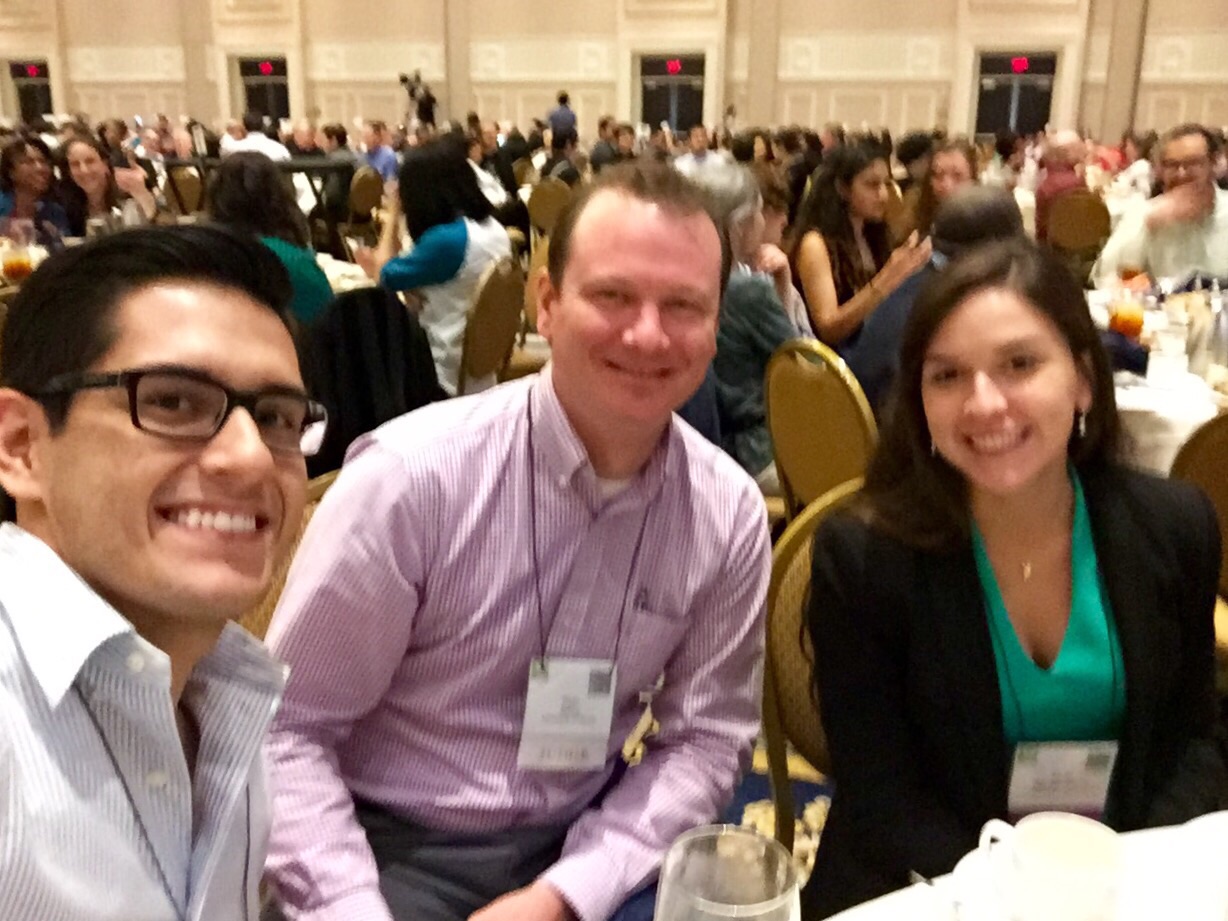Biosensors 2016 Conference
Enrique recently attended the Biosensors 2016 Congress in Gothenburg, Sweden. His talk, Multiplexed detection of clinically-relevant biomarker panels using a silicon photonic biosensing platform: Application to Sepsis and Tuberculosis diagnostics, reported on the lab's recent efforts to transform the microring resonator array technology into a robust in vitro diagnostic platform.
Congrats to Quique on a successful meeting and presentation!
Big Announcement: Bailey Lab Moving to University of Michigan!
Starting in September, the Bailey Lab will move to the University of Michigan in the Department of Chemistry! We welcome motivated undergraduates, graduate students, and postdocs to join the team in the fall. Go Blue!
Congrats to Dan on his recent publication!
Nanoporous Gold Membranes as Robust Constructs for Selectively Tunable Chemical Transport
Daniel A. McCurry, and Ryan C. Bailey J. Phys. Chem. C, Just Accepted Manuscript
DOI: 10.1021/acs.jpcc.6b02759
Abstract
Nanopores are promising structures for small volume separations, but often require complex topdown fabrication and are not easily (re)configurable to allow for dynamically tuned separations. Herein we report the first use of nanoporous gold (NPG) membranes as tunable, charge-based separation elements. NPG is fabricated into a robust network of interconnecting pores via simple solution de-alloying. We demonstrate that control over the selective permeation of small molecule analytes can be controlled via three different methods: 1) anion adsorption at the Au surface; 2) pH-tuning of self-assembled monolayer (SAM) charge; and 3) electrochemical oxidation of a redox-active SAM. This simple and versatile membrane system is promising as a dynamically-tunable element for small volume separations.
Spring 2016 ACS Meeting in San Diego
During the Spring 2016 American Chemical Society Meeting in San Diego, CA, Alex Stanton and Kali Miller presented an update of their collaborative work using silicon photonic microring resonators for chemical agent transport. This work was nominated for the Polymeric Materials Science and Engineering Distinguished Poster Award.


Pittcon 2016 in Atlanta
A group from the lab headed down to Atlanta for Pittcon 2016. Several sit-down meals were enjoyed! It gave us a chance to sample new food and catch up with old friends.



Bailey Lab Tailgate: Illinois vs Ohio State


SACNAS 2015 National Conference
Ryan, Alex, and Ruth recently attended the SACNAS National Conference held in Washington D.C. SACNAS (the Society for the Advancement of Chicanos and Native Americans in Science) is an organization dedicated to the success of Chican@, Hispanic, Latin@, and Native American scientists to attain positions of leadership in government, industry, and academia. Alex is president of the UIUC chapter, while Ryan is a faculty adviser for the chapter's successful Cena y Ciencias outreach program. This year, the UIUC chapter won Graduate Chapter of the Year, and four members won individual awards for their research presentations. Ryan was one of six presenters giving a workshop on how to establish an active outreach program with local elementary schools.




2015 Turkey Run Analytical Conference
The Bailey Lab successfully participated in the 2015 Turkey Run Analytical Conference. Here are some highlights from the conference.












Highlight of Recent Publications
Congratulations to Enrique, Winnie, and James on their recent publications.
Rapid, Multiplexed Phosphoprotein Profiling Using Silicon Photonic Sensor Arrays
James H. Wade, Aurora T. Alsop, Nicholas R. Vertin, Hongwei Yang, Mark D. Johnson, and Ryan C. Bailey
ACS Central Science (2015) DOI: 10.1021/acscentsci.5b00250
Abstract: Extracellular signaling is commonly mediated through post-translational protein modifications that propagate messages from membrane-bound receptors to ultimately regulate gene expression. Signaling cascades are ubiquitously intertwined, and a full understanding of function can only be gleaned by observing dynamics across multiple key signaling nodes. Importantly, targets within signaling cascades often represent opportunities for therapeutic development or can serve as diagnostic biomarkers. Protein phosphorylation is a particularly important post-translational modification that controls many essential cellular signaling pathways. Not surprisingly, aberrant phosphorylation is found in many human diseases, including cancer, and phosphoprotein-based biomarker signatures hold unrealized promise for disease monitoring. Moreover, phosphoprotein analysis has wide-ranging applications across fundamental chemical biology, as many drug discovery efforts seek to target nodes within kinase signaling pathways. For both fundamental and translational applications, the analysis of phosphoprotein biomarker targets is limited by a reliance on labor-intensive and/or technically challenging methods, particularly when considering the simultaneous monitoring of multiplexed panels of phosphoprotein biomarkers. We have developed a technology based upon arrays of silicon photonic microring resonator sensors that fills this void, facilitating the rapid and automated analysis of multiple phosphoprotein levels from both cell lines and primary human tumor samples requiring only minimal sample preparation.
Development and validation of an immunosensor for monocyte chemotactic protein 1 using a silicon photonic microring resonator biosensing platform
Enrique Valera, Winnie W. Shia, and Ryan C. Bailey
Clinical Biochemistry (2015) DOI: 10.1016/j.clinbiochem.2015.09.001
Objectives
We report the development of an optical immunosensor for the detection of monocyte chemotactic protein 1 (MCP-1) in serum samples. MCP-1 is a cytokine that is an emerging biomarker for several diseases/disorders, including ischemic cardiomyopathy, fibromyalgia, and some cancers.
Design and methods
The detection of MCP-1 was achieved by performing a sandwich immunoassay on a silicon photonic microring resonator sensor platform. The resonance wavelengths supported by microring sensors are responsive to local changes in the environment accompanying biomarker binding. This technology offers a modularly multiplexable approach to detecting analyte localization in an antibody-antigen complex at the sensor surface.
Results
The immunosensor allowed the rapid detection of MCP-1 in buffer and spiked human serum samples. An almost 2 order of magnitude linear range was observed, between 84.3 and 1582.1 pg/mL and the limits of blank and detection were determined to be 0.3 and 0.5 pg/mL, respectively. The platform's ability to analyze MCP-1 concentrations across a clinically-relevant concentration range was demonstrated.
Conclusions
A silicon photonic immunosensor technology was applied to the detection of clinically-relevant concentrations of MCP-1. The performance of the sensor was validated through a broad dynamic range and across a number of suggested clinical cut-off values. Importantly, the intrinsic scalability and rapidity of the technology makes it readily amenable to the simultaneous detection of multiplexed biomarker panels, which is particularly needed for the clinical realization of inflammatory diagnostics.







